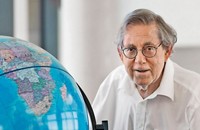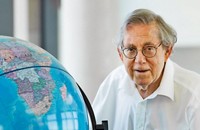Advertisement
Grab your lab coat. Let's get started
Welcome!
Welcome!
Create an account below to get 6 C&EN articles per month, receive newsletters and more - all free.
It seems this is your first time logging in online. Please enter the following information to continue.
As an ACS member you automatically get access to this site. All we need is few more details to create your reading experience.
Not you? Sign in with a different account.
Not you? Sign in with a different account.
ERROR 1
ERROR 1
ERROR 2
ERROR 2
ERROR 2
ERROR 2
ERROR 2
Password and Confirm password must match.
If you have an ACS member number, please enter it here so we can link this account to your membership. (optional)
ERROR 2
ACS values your privacy. By submitting your information, you are gaining access to C&EN and subscribing to our weekly newsletter. We use the information you provide to make your reading experience better, and we will never sell your data to third party members.
People
Movers And Shakers
Mario Molina
After winning the Presidential Medal of Freedom, the Nobelist reflects on his career and the need for chemists to serve society
by Cheryl Hogue
December 9, 2013
| A version of this story appeared in
Volume 91, Issue 49

At first glance, the crowd seated on the stage seemed like an unusual one to include a scientific luminary. Entertainer Oprah Winfrey was there, along with writer and feminist Gloria Steinem and former Chicago Cubs shortstop and first baseman Ernie Banks. And sitting behind former president Bill Clinton and next to country music legend Loretta Lynn was chemist and Nobel Laureate Mario J. Molina.
They had assembled in the East Room of the White House for a solemn ceremony last month. One by one, they were called to their feet. President Barack Obama draped each person’s neck with a ribbon holding the Presidential Medal of Freedom, the nation’s highest civilian award.
Molina was selected to receive this honor, the White House says, because he is “a visionary chemist and environmental scientist.” In the 1970s, Molina and the late F. Sherwood Rowland described how chlorofluorocarbons can break down stratospheric ozone. In 1995, Molina shared the Nobel Prize in Chemistry with Rowland and Dutch chemist Paul J. Crutzen for elucidating the formation and decomposition of stratospheric ozone.
Molina wears many hats. He is a distinguished professor of chemistry and biochemistry at the University of California, San Diego, and a professor at the Center for Atmospheric Sciences at Scripps Institution of Oceanography. He’s also director of the Mario Molina Center for Strategic Studies in Energy & the Environment in Mexico City. He serves on the President’s Council of Advisors on Science & Technology and is a member of the National Academy of Sciences and the Institute of Medicine.
The Presidential Medal of Freedom is one of many awards that he has received over his distinguished career. As Molina, 70, looks back, winning the Nobel was surely the acme. Yet he recalls with pride other highlights from his decades as a chemist.
One high point is related to his research as a doctoral student at UC Berkeley.
“I was working with chemical lasers,” Molina tells C&EN. “There were some very special-looking signals that people had not paid much attention to before. I was able to understand them and have the mathematical insights to see where these come from. Finding something new that had not been observed or understood by anyone else before is just one of those very exciting things that happen when you do research.”
Molina says he is also “proud of recognizing that as a scientist, it was not only important to do research and find new things. I also felt a responsibility to apply them for the benefit of society.
“As I was starting my academic career, it was almost considered to be a negative signal to your career to get involved in politics” and to give interviews to the news media, Molina explains. “But to me that was a sign you were doing something useful.”
Over the years, Molina has become increasingly involved with policy issues—notably air pollution in megacities of the developing world and global climate change—that involve a great deal of chemistry. “Rather than doing research in the conventional way a professor does, I found I could have more impact in the science policy field,” Molina says.
Looking to the future, Molina is particularly troubled by human-caused climate change. “It’s a problem that society has not really faced in an appropriate fashion. The science here is complicated, and we don’t have certainty,” he says. But, he warns, “there is a risk that we might do very serious damage to the environment, to the atmosphere, to the planet. It’s very clear that the cost of the impacts will be larger than the cost associated with taking the necessary measures” to forestall climate change.
Even with all of his policy work, Molina’s first love is the central science, a relationship sparked decades ago when he was a boy in Mexico City experimenting with a chemistry set. “I find it fascinating to find out how nature works, how things function, and even creating new things,” he says.
Molina says he tells young people to “do something you like, do it with passion; see that you do something that benefits society. That’s extremely rewarding.”
To his fellow chemists already working in the field, Molina, a 42-year member of the American Chemical Society, says: “Keep up the good work. It’s very clear that chemistry has been crucial for the evolution of society. Chemistry has given us enormous benefits in our standard of living.
“Of course, like with any large-scale set of activities, you can have problems. So let’s just be aware of those problems. With creativity, we can solve them,” he says.
“Chemistry’s overall potential for advancing civilization is enormous,” Molina adds. “Let’s get working.”





Join the conversation
Contact the reporter
Submit a Letter to the Editor for publication
Engage with us on Twitter